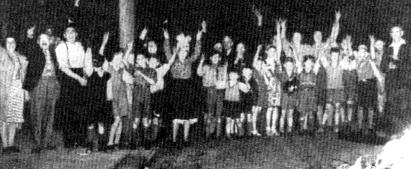End of War Anniversary Special
Local historian John Gent delves into the archives and his own memories to recount the joy and relief felt by the people of Croydon at the end of the Second World War.
The year 1945 started with severe frosts which had caused a large number of birds to die. There were numerous accidents on ice-covered roads and many people enjoyed skating on the ponds in Wandle Park.
The Croydon Times of 6th January reported that 15,529 houses in the town still awaited repair to the damage caused by doodle-bug (V1) and rocket (V2) attacks in 1944. The first few bombed-out families were expected to move into emergency huts which had been built in Haslemere Road, Thornton Heath, and the maximum rent was set at 10/- (50p) a week. During the first weeks of 1945, the fairly frequent sound of exploding V2 rockets could still be heard.
Two fell in Croydon: the first at Addington, on the night of 5 & 6th January, the second at Lloyd Park on 26th January - both, fortunately, on open land. The last to hit the country fell in Orpington on 27th March - and the aerial attacks on Great Britain were over. Meanwhile, news came almost daily of Allied forces advancing on the Continent as German troops retreated By the beginning of May, peace was expected at any time and, on 4th May, Germany surrendered unconditionally. VE (Victory in Europe) Day was decreed for 8th May and that and the following day were to be public holidays.
The headline in the Croydon Times of Saturday, 12th May, read Bomb scarred Croydon's salute to victory. The paper reported that crowds had thronged the streets in the bright morning sunshine of VE Day.
As the day progressed, many went to church and thousands of people assembled in Katharine Street at 3pm to hear Prime Minister Winston Churchill's historic announcement of the cessation of hostilities in Europe relayed by loudspeakers outside the town hall. At 4pm, a peal of eight bells erected on a platform in front of the Braithewaite Hall, preceded a short service of thanksgiving conducted by the Mayor of Croydon, town council and leading townspeople.
By the evening, the main streets were packed with laughing, happy crowds and the revelry went on well past midnight with dancing around bonfires, many in local streets. Thousands flocked to Addington Hills to get a bird's-eye view of the bonfires and ring of massed waving searchlight beams all over London.
On the following Sunday, nearly 5,000 men, women and children marched through the town, representing every part of civilian Croydon's war effort. Led by the Central Band of The London Fire Forces, the parade was more than a mile long and passed crowds of cheering citizens on its way to Katharine Street, where the Bishop of Croydon conducted a Thanksgiving Service. There were some complaints that the local celebrations had not been very well organised, but preparations for VJ (Victory over Japan) Day had been made well in advance. The news of Japan's surrender came over the radio at midnight on Tuesday, 14th August Shunting engines at Norwood Junction immediately started sounding their whistles to welcome the news. Many people had waited up in anticipation of the news and commenced their celebrations straight away.
Crowds began to gather in the main streets and cheering, singing and dancing went on through the early hours. Flags, bunting and illuminations soon appeared all over town. Heavy rain kept the size of the crowds down in the morning, but the sun broke through and a large crowd gathered outside the town hall to listen to the Mayor's victory address.
By 8pm, the town centre was packed. Thousands crowded into Katharine Street to listen to the King's speech, relayed over loudspeakers. Floodlights were switched on and the town hall dancing in the Fairfield car park (at that time uncovered) until midnight, and Ernest Longstaff of the BBC led the crowds in community singing.
Croydon Corporation had arranged bonfires at Duppas Hill, Pollards Hill and Addington Hills and there were many street bonfires. At midnight, a chanting, cheering procession of more than a thousand people danced and sang their way through the town centre, clanging dustbin lids as they went.

A huge statue of Peace was erected outside Kennards department store in North End (the site is now occupied by Debenhams) and most buildings were decorated. Street parties were held all over the town.
It must be almost impossible, 60 years on, for those who were not there to appreciate the great sense of relief and happiness that swept over the country after six long years of war.
I recollect it as though it were yesterday, having joined in dancing the hokey cokey and the conga in a deliriously happy crowd in Thornton Heath's High Street. But, little did any of us realise, years of great hardship and shortages were to still to come and that rationing would not come to an end until 1954.
The war was over but, for the many who lost homes and family members, life would never be the same and they would not forget.
